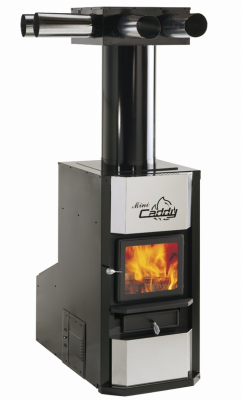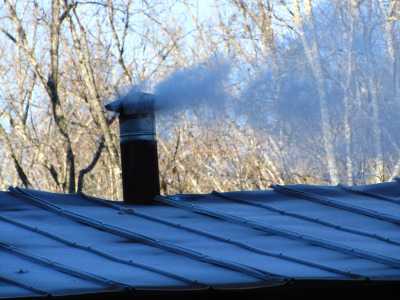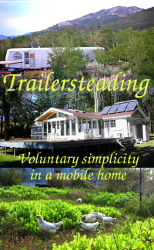
Disadvantages of exterior wood furnaces
 We were thrilled when Mark's
mom gave us an external wood
furnace
a couple of years ago, and we are still very grateful. However,
over time, we've discovered that external wood furnaces have a variety
of problems associated with them:
We were thrilled when Mark's
mom gave us an external wood
furnace
a couple of years ago, and we are still very grateful. However,
over time, we've discovered that external wood furnaces have a variety
of problems associated with them:
- Extremely inefficient. Even the most efficient new wood furnance I could find in my web searches (the Mini-Caddy, listed as an Energy Star furnace, and pictured here) is vastly inferior to moderately efficient wood stoves. You can download a list of EPA certified wood stoves which will tell you the emissions and efficiency of all tested models. The Caddy, which the Mini-Caddy is based on, has 6.6 g/hr emissions and 63% efficiency. Compare it, for example, to the Drolet Savannah wood stove (which has slightly less output than the Mini-Caddy and is much cheaper) --- 6.28 g/hr emissions and 75% efficiency.
- Expensive. We got very lucky and were given our furnace as a gift, so I wasn't prepared for the price tag when we considered upgrading to a more efficient model. The Mini-Caddy seems to retail for somewhere in the $2,000 range, compared to efficient, non-catalytic wood stoves that can be got for closer to $700 (and which also have higher efficiency, don't forget.) You can get a 30% federal tax credit on either purchase.
 Not suited
for indoor use. After finishing up the East Wing, we moved
in our wood furnace, figuring that we'd be able to capture some of the
heat previously lost to the outside air. I know that the term "exterior
wood furnace" should have tipped me off, but we were shocked at how
smoky the East Wing got when we lit our first fire this year.
Granted, our model (LTD Limited by Jordahl Mfg.) is very old, and its
drawing problem may not be
found in more modern wood furnaces.
Not suited
for indoor use. After finishing up the East Wing, we moved
in our wood furnace, figuring that we'd be able to capture some of the
heat previously lost to the outside air. I know that the term "exterior
wood furnace" should have tipped me off, but we were shocked at how
smoky the East Wing got when we lit our first fire this year.
Granted, our model (LTD Limited by Jordahl Mfg.) is very old, and its
drawing problem may not be
found in more modern wood furnaces.
- Fails during power outages.
Without
electricity to turn on the electric fan, we had to burn huge fires in
our furnace to keep the trailer at all habitable during last year's 10
day power outage.
 Is meant to
heat the whole house rather than a small section. You have
to burn a lot more wood in general to keep your house warm using an
exterior furnace since you depend on fans to move the hot air
throughout the house. With an indoor wood stove, you can situate
the stove in the population center of the house and burn small fires to
heat just that area.
Is meant to
heat the whole house rather than a small section. You have
to burn a lot more wood in general to keep your house warm using an
exterior furnace since you depend on fans to move the hot air
throughout the house. With an indoor wood stove, you can situate
the stove in the population center of the house and burn small fires to
heat just that area.
All told, our exterior
wood furnace has definitely been better than
heating with electric space heaters, but we run through wood like
nobody's business. This week, I'm going to post about some of the
options we're considering --- I suspect you'll all have good advice, so
please chime in!
| This post is part of our Wood Stove lunchtime series.
Read all of the entries: |

Edited to add:
Learn how to safely install an energy-efficient wood stove in a moibile
home in Trailersteading. Now available for
$1.99 on Amazon.
Want more in-depth information? Browse through our books.
Or explore more posts by date or by subject.
About us: Anna Hess and Mark Hamilton spent over a decade living self-sufficiently in the mountains of Virginia before moving north to start over from scratch in the foothills of Ohio. They've experimented with permaculture, no-till gardening, trailersteading, home-based microbusinesses and much more, writing about their adventures in both blogs and books.
Want to be notified when new comments are posted on this page? Click on the RSS button after you add a comment to subscribe to the comment feed, or simply check the box beside "email replies to me" while writing your comment.

Have a look at wood gasifiers. Those can be very efficient (up to 94%) and have a very complete combustion due to the high temperatures, so no smoke. I looked at them when my old gas furnace was acting up, but I don't have a ready source of wood available. Most gasifiers do need electricity for the fans and the control circuitry. But a solar-powered battery pack might help there in case of power outages.
Some brands I've found were atmos, [orlan (in Dutch)][] and eta. The atmos machines meet the highest European standard for pollution (EN 303-5 class 3).
I think Mark would like GEK's gasifier experiment kit. Their power pallet could deliver both heat and electricity. The problem is that the need for power and electricity isn't always coupled, and I don't know how versatile this machine is. And I guess you'd also like their biochar machine. What I like is that their designs are open source, and use off-the-shelf parts where possible. If I had a house in the country with a lot of wood, I'd be tempted to get a power pallet. Or use the gasifier to make fuel for a small gas turbine driving a generator.
Their power pallet could deliver both heat and electricity. The problem is that the need for power and electricity isn't always coupled, and I don't know how versatile this machine is. And I guess you'd also like their biochar machine. What I like is that their designs are open source, and use off-the-shelf parts where possible. If I had a house in the country with a lot of wood, I'd be tempted to get a power pallet. Or use the gasifier to make fuel for a small gas turbine driving a generator. 
It does not only depend on size, but also on how well insulated your trailer is, how warm you want it and if you also want it to heat tapwater. The gas heater for my flat is rated between 6-24 kW.
You can also get a modern wood stove. Those can be up to 80% efficient. But do get a model that takes its combustion air from the outside. Preferably by means of a concenctric pipe around the exhaust, so the exhaust gasses pre-heat the combustion air.
A soapstone stove gives off an even heat long after the wood has burned down, but can still has a hot fire for efficient combustion. They do tend to be heavy, though.
Or maybe a rocket stove mass heater will do?
I don't agree with his assessment. (a bit long and maybe rambling, it's late and I need to catch some sleep)
When open coal furnaces were common in the Netherlands, there were large numbers of fatalities and hospitalizations due to carbon monoxide poisoning. This decreased somewhat when most people switched to natural gas. But still there were a significant number of deaths and hospitalizations. So at a certain moment open hearts and central heating devices >20 kW were banned. Between 1970 an 2008, deaths trough accidental poisonings in the Netherlands dropped by 23% (source: www.swov.nl, unfortunately CO poisonings aren't registered seperately).
Current hearts >20 kW must be enclosed and get their oxygen from outside. Modern heaters all have forced ventilation for reasons I'll explain below.
I disagree that a passive air supply is useless. If the leaks around windows and doors didn't form a passive air supply, you'd poison yourself every time you lit a fire! If his argument is that a passive air supply doesn't reliably supply combustion air, than how come the normal leak spots in a house are enough?
WRT air blowing into the chimney; normally the weatherhood is designed to prevent air blowing into the chimney. There is however a tension between efficiency of a furnace and draft! A very efficient furnace will have a relatively low exhaust temperature. But a higher exhaust temperature will draft better.
Essentially for a furnace without separate and forced ventilation, the hot exhaust gas is the "engine" that has to pull the air through the gaps around doors and windows and through other leaks into the house and then through the furnace. If the house is relatively leaky, this is quite easy. But the better a house is insulated and people have been sealing leaks, the harder it becomes for the fire to get enough oxygen. Personally I think it is better for a fire to have an air supply directly to the combustion chamber, preferably with a heat exchanger to let the exhaust gases heat the incoming air, and not leave that to the vagaries of chance.
Basically, there are several things you'd want from a good (wood) heater
Matt --- Excellent point on the efficiency numbers. I didn't realize that until I started researching efficient stoves in more depth. Do you know of a better source that gives actual efficiency numbers for stoves?
We decided to go with a small, indoor, efficient stove, and have been very happy with it!